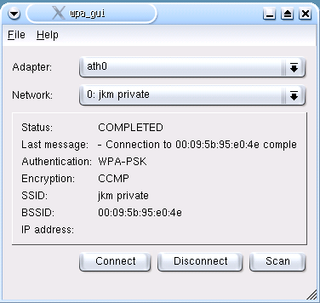Protocol operation
IEEE 802.11i enhances IEEE 802.11-1999 by providing a Robust Security Network (RSN) with two new protocols: the four-way handshake and the group key handshake. These utilize the authentication services and port access control described in IEEE 802.1X to establish and change the appropriate cryptographic keys. [2] [3] The RSN is a security network that only allows the creation of robust security network associations (RSNAs), which are a type of association used by a pair of stations (STAs) if the procedure to establish authentication or association between them includes the 4-Way Handshake. [4]
The standard also provides two RSNA data confidentiality and integrity protocols, TKIP and CCMP, with implementation of CCMP being mandatory since the confidentiality and integrity mechanisms of TKIP are not as robust as those of CCMP. [5] The main purpose to implement TKIP was that the algorithm should be implementable within the capabilities of most of the old devices supporting only WEP.
The initial authentication process is carried out either using a pre-shared key (PSK), or following an EAP exchange through 802.1X (known as EAPOL, which requires the presence of an authentication server). This process ensures that the client station (STA) is authenticated with the access point (AP). After the PSK or 802.1X authentication, a shared secret key is generated, called the Pairwise Master Key (PMK). In PSK authentication, the PMK is actually the PSK, [6] which is typically derived from the WiFi password by putting it through a key derivation function that uses SHA-1 as the cryptographic hash function. [7] If an 802.1X EAP exchange was carried out, the PMK is derived from the EAP parameters provided by the authentication server.
Four-way handshake
The four-way handshake [8] is designed so that the access point (or authenticator) and wireless client (or supplicant) can independently prove to each other that they know the PSK/PMK, without ever disclosing the key. Instead of disclosing the key, the access point (AP) and client encrypt messages to each other—that can only be decrypted by using the PMK that they already share—and if decryption of the messages was successful, this proves knowledge of the PMK. The four-way handshake is critical for protection of the PMK from malicious access points—for example, an attacker's SSID impersonating a real access point—so that the client never has to tell the access point its PMK.
The PMK is designed to last the entire session and should be exposed as little as possible; therefore, keys to encrypt the traffic need to be derived. A four-way handshake is used to establish another key called the Pairwise Transient Key (PTK). The PTK is generated by concatenating the following attributes: PMK, AP nonce (ANonce), STA nonce (SNonce), AP MAC address, and STA MAC address. The product is then put through a pseudo-random function. The handshake also yields the GTK (Group Temporal Key), used to decrypt multicast and broadcast traffic.
The actual messages exchanged during the handshake are depicted in the figure and explained below (all messages are sent as EAPOL-Key frames):
- The AP sends a nonce-value (ANonce) to the STA together with a Key Replay Counter, which is a number that is used to match each pair of messages sent, and discard replayed messages. The STA now has all the attributes to construct the PTK.
- The STA sends its own nonce-value (SNonce) to the AP together with a Message Integrity Code (MIC), including authentication, which is really a Message Authentication and Integrity Code (MAIC), and the Key Replay Counter which will be the same as Message 1, to allow AP to match the right Message 1.
- The AP verifies Message 2, by checking MIC, RSN, ANonce and Key Replay Counter Field, and if valid constructs and sends the GTK with another MIC.
- The STA verifies Message 3, by checking MIC and Key Replay Counter Field, and if valid sends a confirmation to the AP.
Group key handshake
The Group Temporal Key (GTK) used in the network may need to be updated due to the expiration of a preset timer. When a device leaves the network, the GTK also needs to be updated. This is to prevent the device from receiving any more multicast or broadcast messages from the AP.
To handle the updating, 802.11i defines a Group Key Handshake that consists of a two-way handshake:
- The AP sends the new GTK to each STA in the network. The GTK is encrypted using the KEK assigned to that STA, and protects the data from tampering, by use of a MIC.
- The STA acknowledges the new GTK and replies to the AP.





